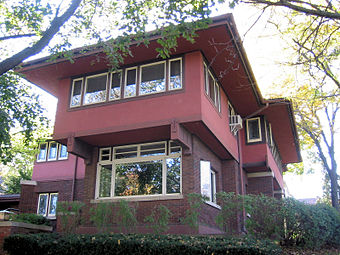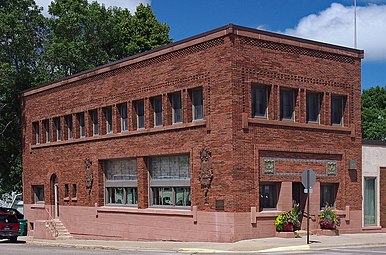
East Isles is a neighborhood within the larger Calhoun Isles community in Minneapolis, Minnesota, United States.

Prairie School is a late 19th and early 20th-century architectural style, most common in the Midwestern United States. The style is usually marked by horizontal lines, flat or hipped roofs with broad overhanging eaves, windows grouped in horizontal bands, integration with the landscape, solid construction, craftsmanship, and discipline in the use of ornament. Horizontal lines were thought to evoke and relate to the wide, flat, treeless expanses of America's native prairie landscape.
William Gray Purcell was a Prairie School architect in the Midwestern United States. He partnered with George Grant Elmslie, and briefly with George Feick. The firm of Purcell & Elmslie produced designs for buildings in twenty-two states, Australia, and China. The firm had offices in Minneapolis, Minnesota; Chicago, Illinois; Philadelphia, Pennsylvania; and Portland, Oregon.
George Grant Elmslie was an American Prairie School architect whose works are is mostly found in the Midwestern United States. He worked with Louis Sullivan and later with William Gray Purcell as a partner in the firm Purcell & Elmslie.

William LaBarthe Steele was an American architect from Chicago, Illinois. He is considered a principal member of the Prairie School Architectural Movement during the early 20th century.

Christ Church Cathedral, built in 1916 to replace the earlier 1874 building, is the Episcopal cathedral in Eau Claire, Wisconsin. It is the mother church for the Episcopal Diocese of Eau Claire, the see of which is located in Eau Claire. The cathedral and parish house were added to the National Register of Historic Places in 1982.

The Edna S. Purcell house was designed by the firm of Purcell, Feick and Elmslie for architect William Purcell and his family in 1913. It is located in Minneapolis, Minnesota.
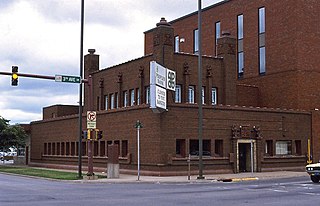
The Peoples Savings Bank in Cedar Rapids, Iowa, was designed by Louis Sullivan. It was the second of a number of small "jewel box" banks in midwest towns designed by Sullivan during 1907 to 1919. It was built in 1911, and it was individually listed on the National Register of Historic Places in 1978. In 2014 it was included as a contributing property in the West Side Third Avenue SW Commercial Historic District.

The Woodbury County Courthouse is located at 620 Douglas Street in Sioux City, the county seat of Woodbury County, Iowa, United States. It is regarded as "one of the finest Prairie School buildings in the United States" and has been declared a National Historic Landmark for its architecture. It is used for legal proceedings in the county.

The First National Bank of Mankato, also known as the Old First National Bank of Mankato and located at 229 South Front Street in Mankato, Minnesota, United States, is a fine example of Prairie School architecture in a commercial building, relating rural life to the development of downtown Mankato as a regional center of commerce and finance. The recently restored exterior is now part of the Mankato Civic Center, the Mayo Clinic Health System Event Center.

Merchants National Bank is a bank building in Winona, Minnesota, United States, designed in the Prairie School architectural style. It was built in 1912 and features elaborate terracotta and stained-glass ornamentation. It was listed on the National Register of Historic Places in 1974 for having state-level significance in the themes of architecture and commerce. It was nominated for being the "largest and probably best example" of the 18 Midwestern banks designed by Purcell, Feick & Elmslie, a significant influence on early-20th-century American architecture. It is also a contributing property to the Winona Commercial Historic District.
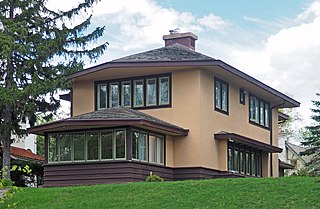
The Dr. Oscar Owre House is a historic house located at 2625 Newton Venue South just north of Lake of the Isles in Minneapolis, Minnesota. It was designed by notable local architects Purcell, Feick & Elmslie in the Prairie School style.
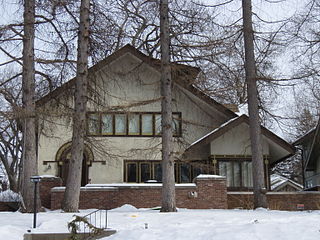
The Charles and Grace Parker House is a house in the Lynnhurst neighborhood of Minneapolis, Minnesota southeast of Lake Harriet. It was designed by notable local architects Purcell, Feick & Elmslie in the Prairie School style. Architecture critic Larry Millett calls it one of Purcell and Elmslie's greatest houses, citing the broad gabled roof, the groupings of windows, the side porch, and the detail surrounding the entry. The entrance includes a fretsawn arch and a frieze above the door, with beams and a pair of pendants on either side. George Grant Elmslie designed the leaded glass windows. The house was listed on the National Register of Historic Places in 1992.

Edwin Hawley Hewitt was an American architect from Minnesota. In 1906, he designed the Edwin H. Hewitt House in the Stevens Square neighborhood of Minneapolis, listed on the National Register of Historic Places in 1978.

Omeyer & Thori was an architectural partnership of Diedrik A. Omeyer (1850-1907) and Martin P. Thori (1864-1905). The two were immigrants from Norway.
Long, Lamoreaux & Long was an architectural partnership in Minneapolis, Minnesota, of Franklin B. Long (1842–1912), Lowell A. Lamoreaux, and Franklin's son Louis L. Long.

George Feick was a German-American builder in Sandusky and Oberlin, Ohio. His works include the Wyoming State Capitol, multiple buildings at Oberlin College, and numerous office buildings, churches, schools, libraries and residences in and around Sandusky. Several of his works are listed on the National Register of Historic Places.

The Ezra Abbott House is a historic house in Owatonna, Minnesota, United States. Built in 1913, it was designed by architects Purcell, Feick & Elmslie in Prairie School style patterned onto American Foursquare massing. The house was listed on the National Register of Historic Places in 1986 for having local significance in the theme of architecture. It was nominated for being a leading example of Purcell, Feick & Elmslie's residential commissions in Southeast Minnesota, and for being Steele County's most outstanding Prairie School building.

The Merton S. Goodnow House at 446 S. Main St. in Hutchinson, Minnesota was built in 1913. It was designed by Purcell, Feick & Elmslie. It was listed on the National Register of Historic Places in 1985.

The Dr. J. W. S. Gallagher House is a 1913 Prairie School house in Winona, Minnesota, United States, designed by the architectural firm of Purcell & Elmslie. The house was listed on the National Register of Historic Places in 1984 for having local significance in the theme of architecture.





